German Bread (Authentic Vollkornbrot)
This post may contain affiliate links. See my disclosure policy.
A thoroughly authentic German Bread Recipe (Vollkornbrot)! This delicious traditional German whole grain seed bread is nutrient dense with a fabulous texture and positively packed with flavor. This makes a large loaf that freezes well so you can conveniently grab some whenever you’re in the mood.
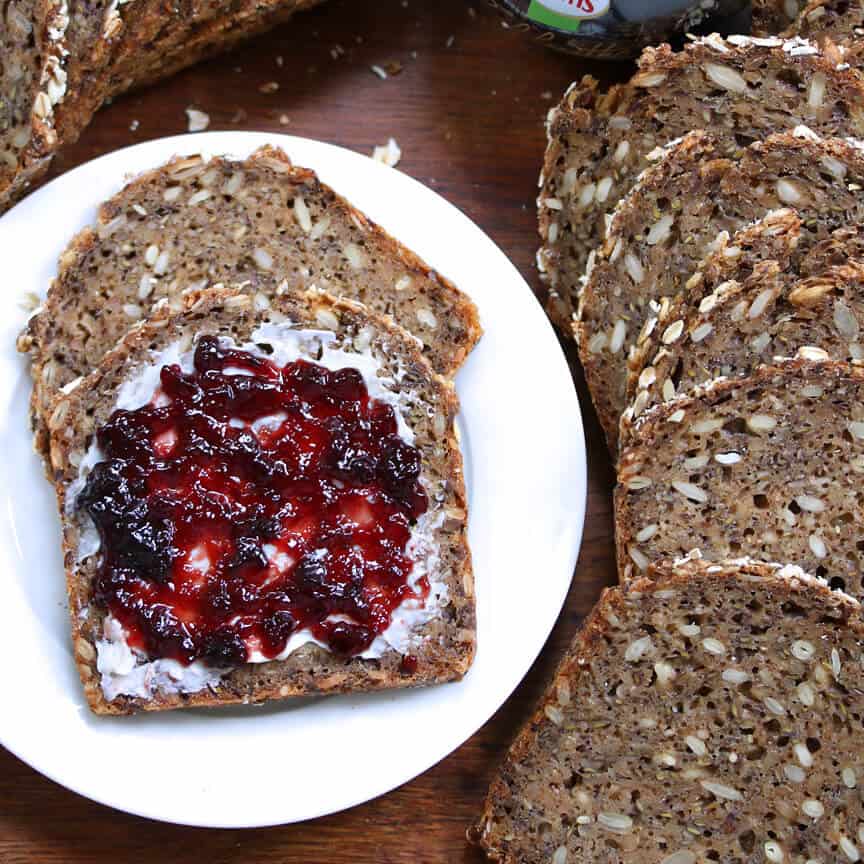
Authentic German Bread (Vollkornbrot)
Few things are better than a freshly baked loaf of bread slathered down with butter and some good jam. That’s true for crusty breads with fluffy interiors and the more hearty, dense breads that I also know and love from Europe. Here is a German bread that is beloved throughout Germany and is also widely enjoyed in Austria and Switzerland. It features a grain called Einkorn that is used throughout much of western Europe, but feel free to substitute other grains according to your preference.
Dense, chewy, packed with nutrition and full of flavor, this whole grain German brown bread (Vollkornbrot) is wonderful with your choice of butter, jam, Nutella, cheese, or cold cuts.
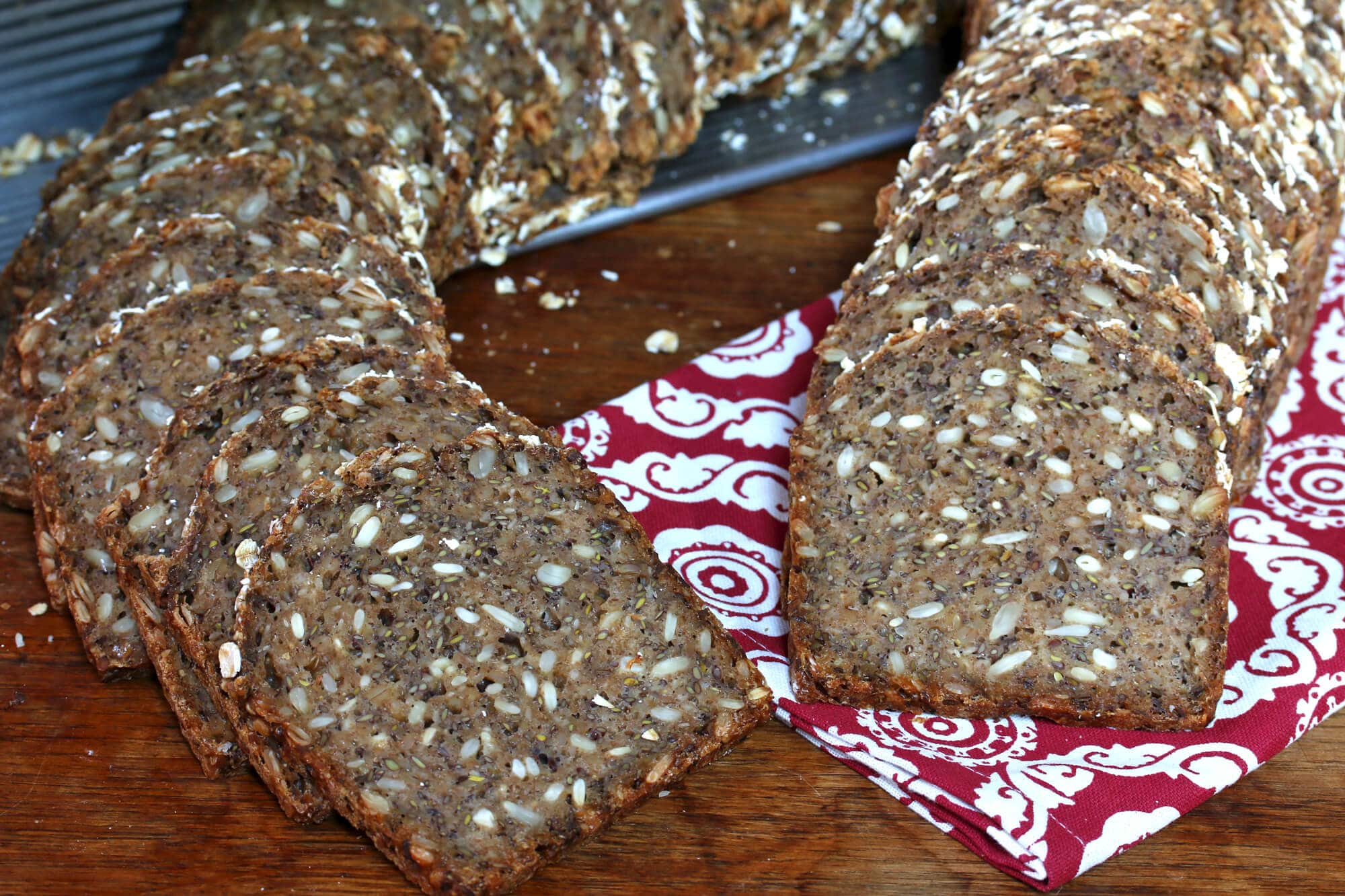
Have you heard of the grain einkorn before? Modern day wheat over the centuries has undergone a series of genetic changes for the purpose of increasing yield and gluten content. It’s almost unidentifiable compared to its ancestor (and my guess is that is why gluten issues are a more recent occurrence). Einkorn is the most ancient form of wheat on earth and hasn’t undergone these genetic changes. It is the purest form of wheat we have. You can purchase einkorn online HERE.
The advantages of einkorn: Most agree it tastes better than wheat and is much easier to digest, even easier than spelt. Compared to the gluten in modern day wheat, it contains a structurally different composition of gluten that the body is able to digest more easily. In fact, some people with gluten issues who have switched to einkorn have found that they’re able to tolerate and digest it with ease.
Even visually there’s a difference between wheat and einkorn. Though there are size variations within different types of wheat, generally most wheat (left) is longer in length than einkorn (right). Einkorn also has a deeper caramel color.

It’s unfortunate that as wonderful as Einkorn is, and common as Einkorn is in many places throughout western Europe, it’s almost unheard of here and very few places sell it. And for that reason it’s also much more expensive here in the U.S.. Hopefully that will change as it becomes more common. The same was true of spelt for a long time and though it’s still far less common than wheat here in the U.S. its price-point has gone down.
I buy all of my grains, including einkorn, in bulk. I take out what I need for a few weeks at a time and store the rest in a dark, cool place. It saves money that way and I have easy access to everything I need. And I LOVE being able to grind my own grains fresh as needed and make up my own fresh baking mixes!
My German-made KoMo grain mill is the pride and joy of my kitchen. German engineering at it’s best, the KoMo grain mill is simply awesome. You can grind your grains as fine or as coarsely as you like. With a 12-year warranty this thing is a work-horse and does a magnificent job. I use it nearly every day grinding my own flours, making cornmeal and a variety of mixes. I cannot recommend it highly enough.

This traditional German bread uses a combination of whole einkorn berries and ground einkorn flour. Whether you’re grinding your own grains or buying the flour already ground, you’re absolutely going to love the texture and flavor of this wonderfully hearty, rustic and thoroughly authentic German bread!
German Sourdough Bread
A couple of our readers have reported back about using sourdough starter instead of yeast. To make this a sourdough Vollkornbrot omit the yeast, add 200 grams of active sourdough starter, and reduce the flour by 100 grams and the water by 100 grams. Give the batter a full 24 hour ferment.
German Bread Recipe (Vollkornbrot)
Let’s get started!
Dissolve the yeast and sugar in the lukewarm water and let sit for 5-10 minutes until frothy. (See above if you prefer to use sourdough starter.)
Place all of the dry ingredients in the bowl of a stand mixer. (You can do this by hand if you prefer.)
NOTE: I personally don’t pre-soak the whole or cracked grain berries and let my batter ferment for a full 24 hours which softens the berries. Depending on the age of the grains you’re using they may require a pre-soaking in order to be adequately soft. If you wish you can pre-soak the grains overnight (pour hot water over them and let them sit) and then thoroughly drain for an hour or so.

Add the yeast mixture along with the buttermilk and beer. Knead on the bread setting (#2) for 10 minutes.
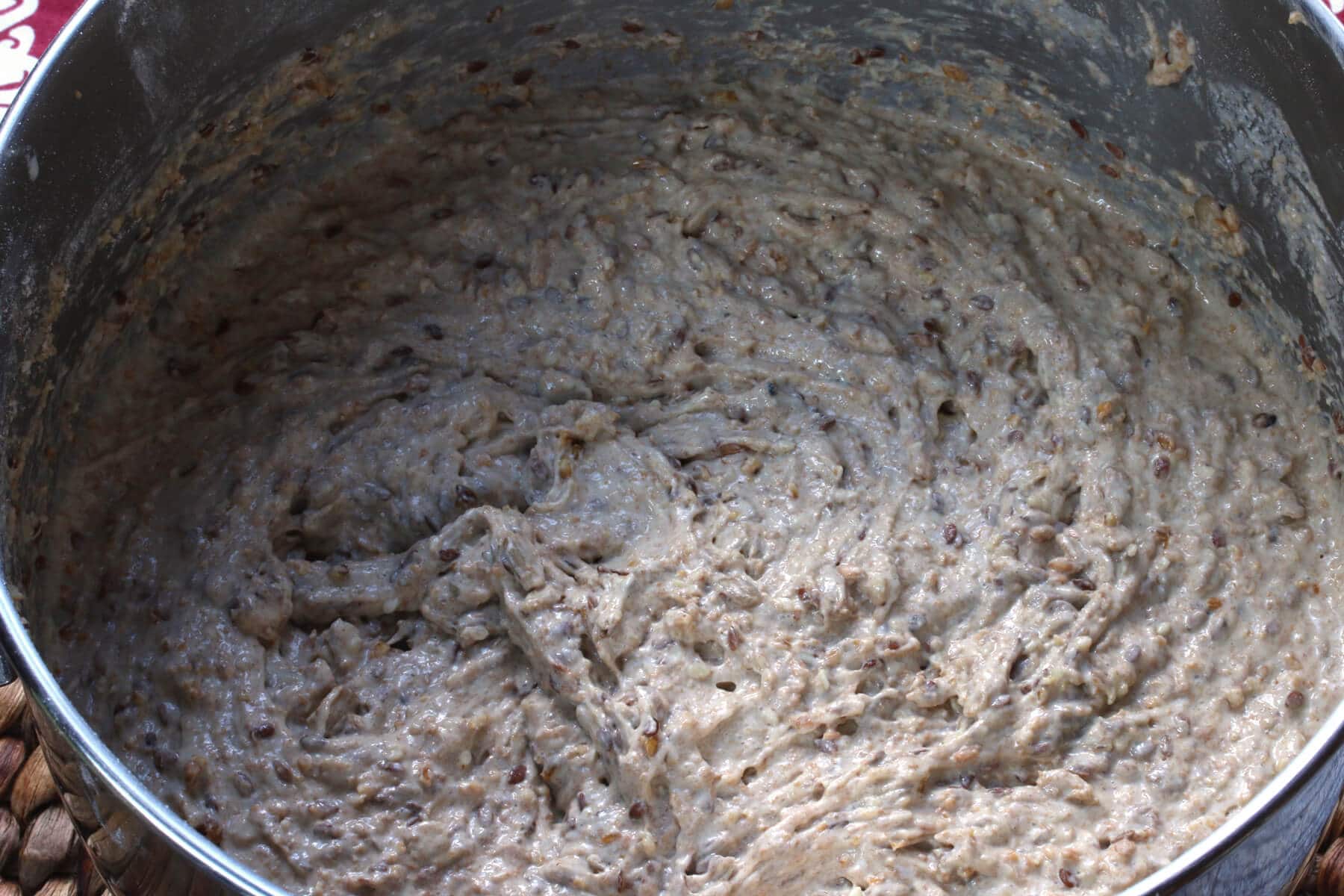
Scoop the mixture into a non-reactive bowl, cover loosely with plastic wrap and let it sit at room temperature for at least 8 hours, preferably longer, up to 24 hours (the longer the better for the whole grain berries to soften and for heightened sourdough properties. If you’re letting it sit for less than 24 hours, presoak the grains overnight in advance and drain thoroughly). Also, the longer it ferments the more liquid will be absorbed so less chances of a moist center after baking.
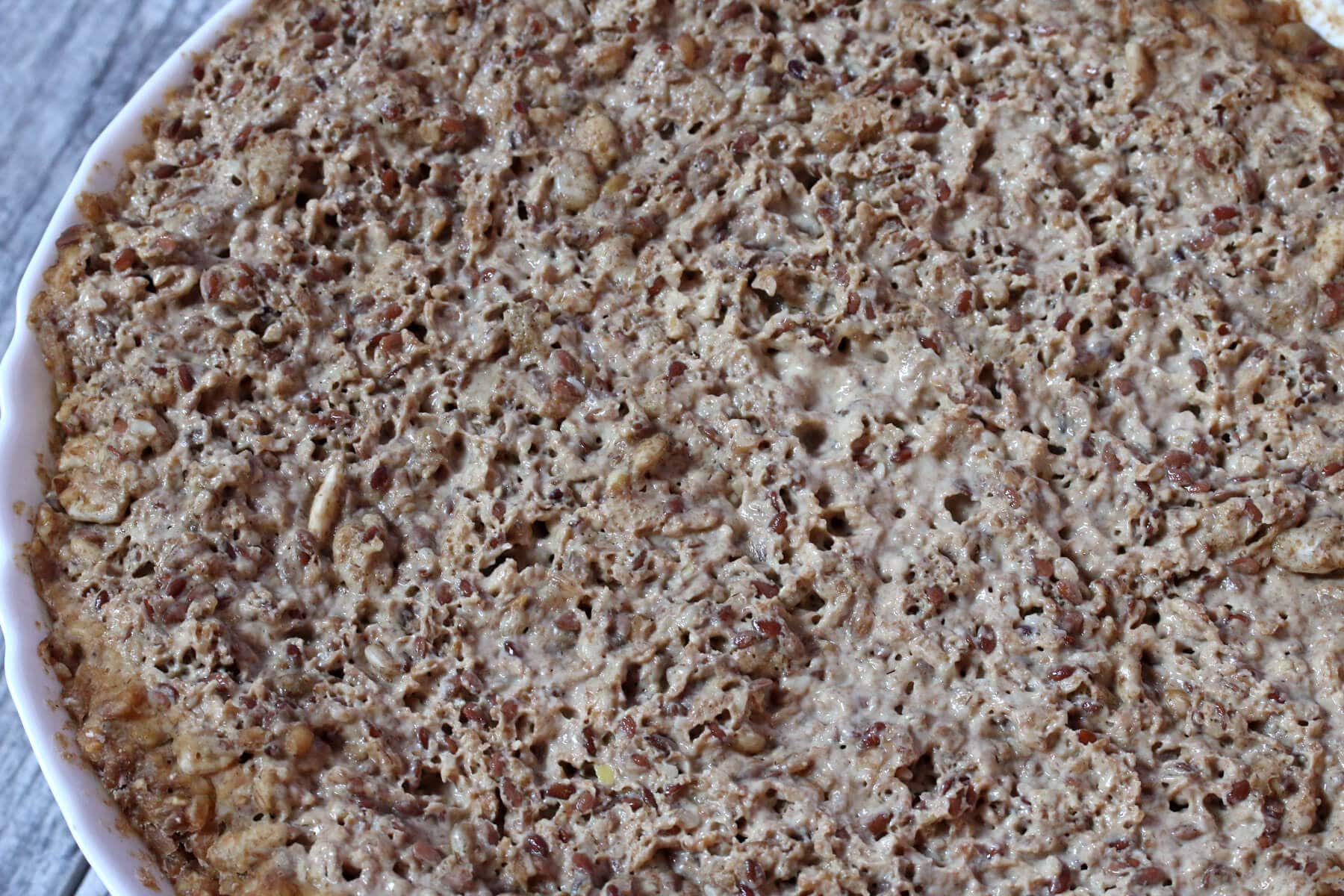
The mixture will be thick and gooey but will not resemble typical bread dough.
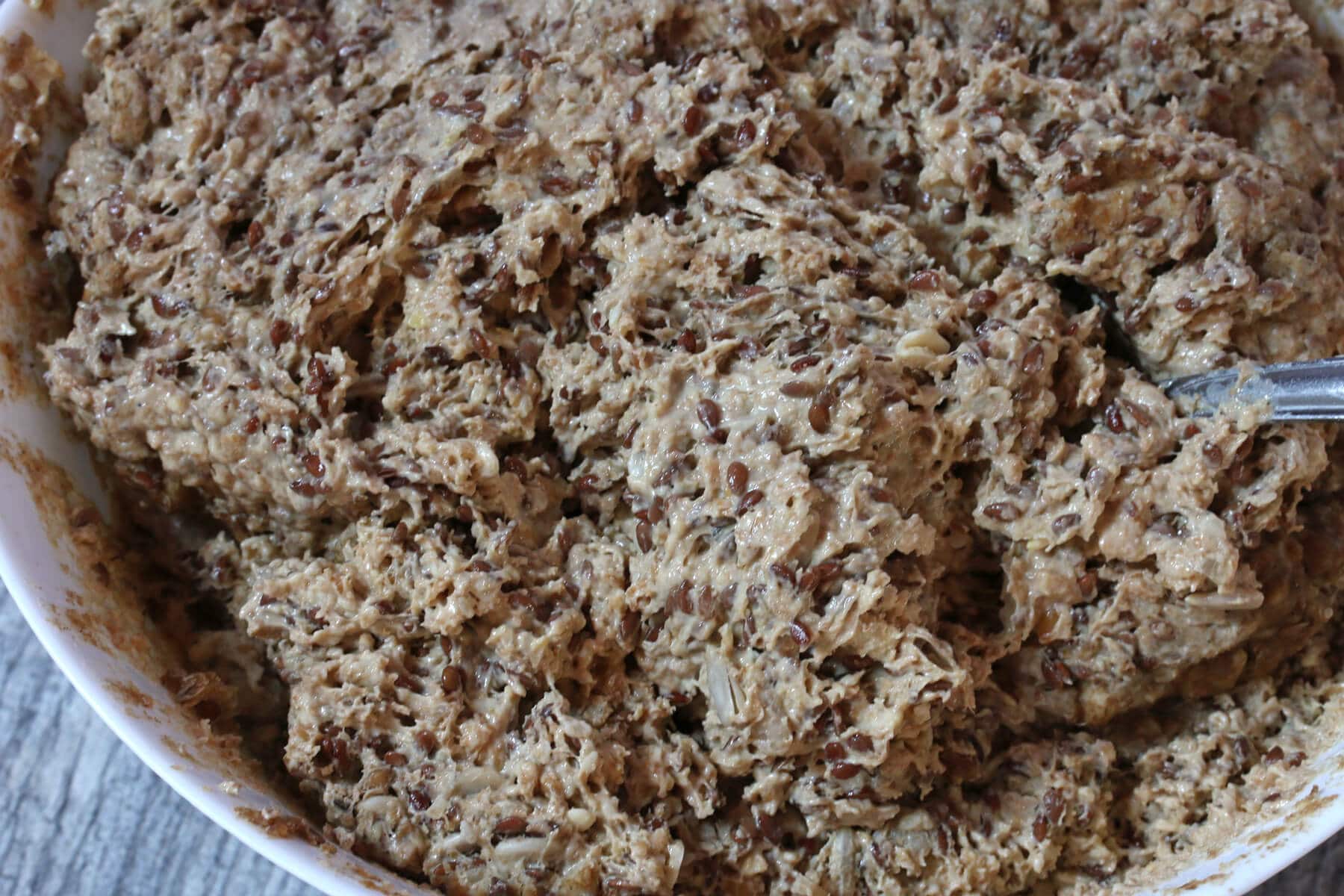
Scoop the mixture into a generously buttered Pullman Loaf Pan and smooth the top so it’s even.
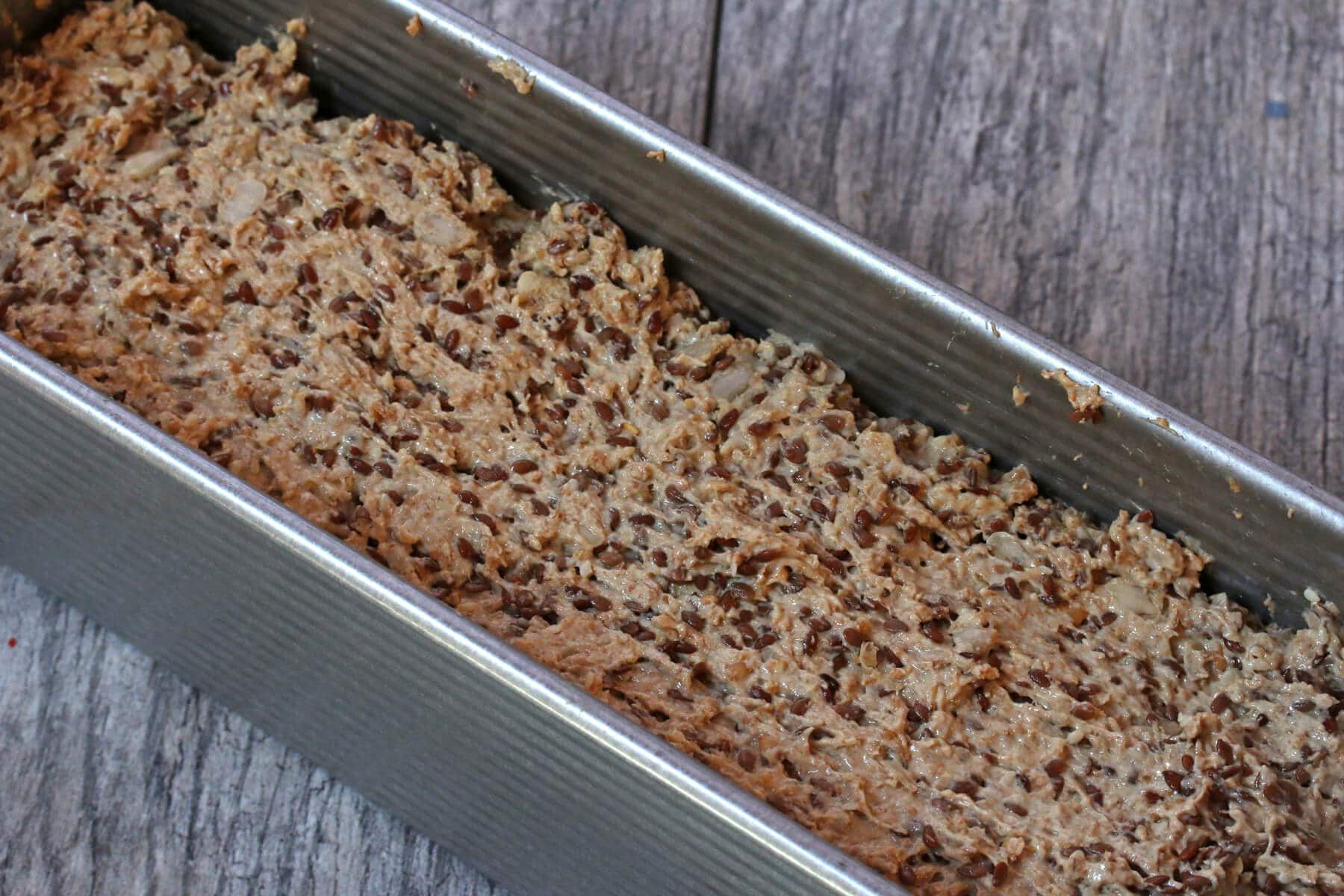
Baking this bread in a Pullman loaf pan yields those nice small, square slices of bread. But it also helps ensure that the center of the bread is fully cooked. Plus, when I’m making other breads that rise a lot, the Pullman has a top on it that slides shut to keep the bread compact (this Einkornbrot doesn’t rise a lot during baking so I don’t bother putting the lid on for it). It’s also the loaf pan that is used to make the famous French pain de mie bread. I like to use it for a lot of my heartier European style breads.
Sprinkle the top with rolled oats.
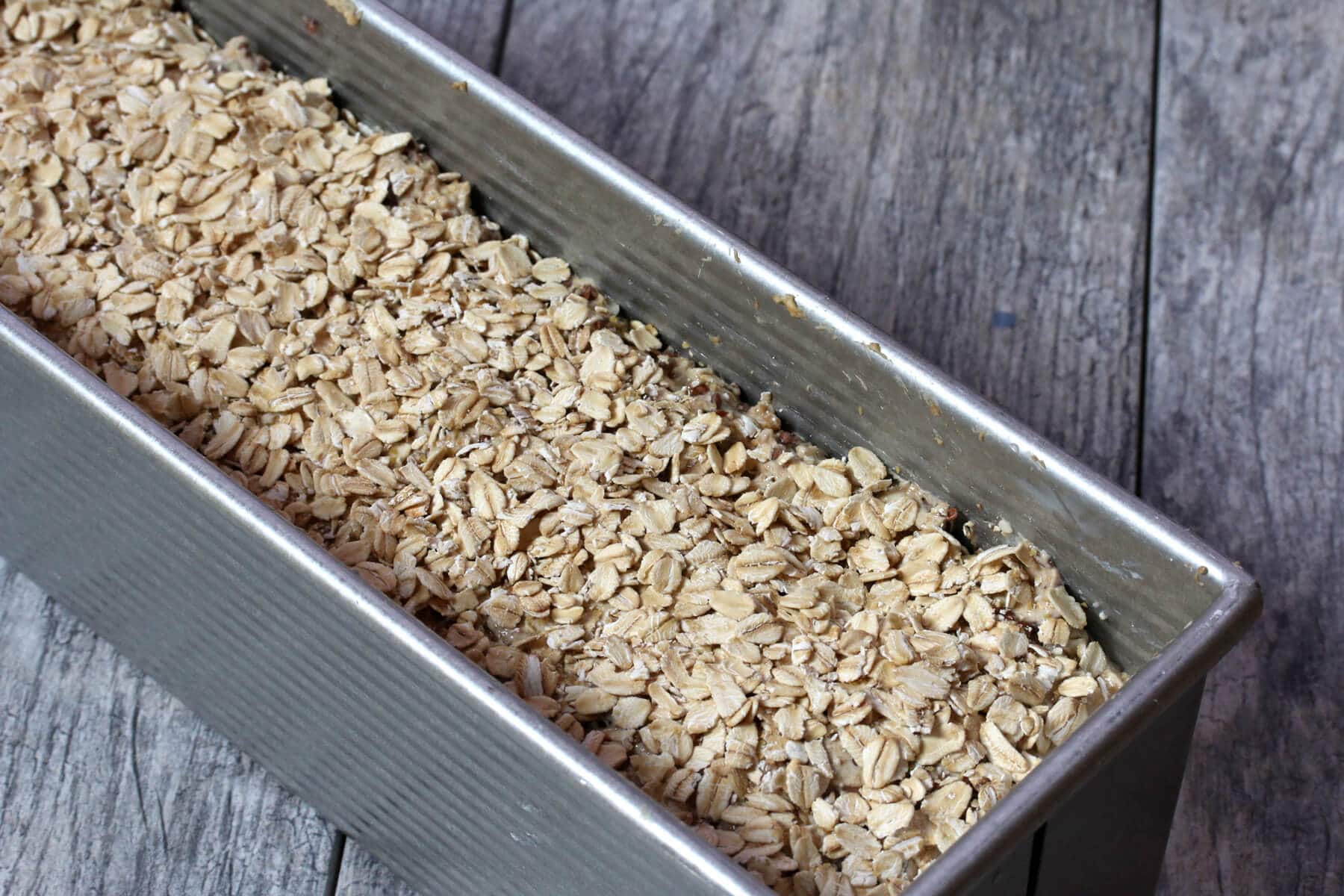
In an oven preheated to 350 degrees F, bake it on the middle rack for 100-120 minutes or until the center is done.
For best and most accurate results, use an instant read thermometer and aim for an internal temperature of 205-210 degrees F.
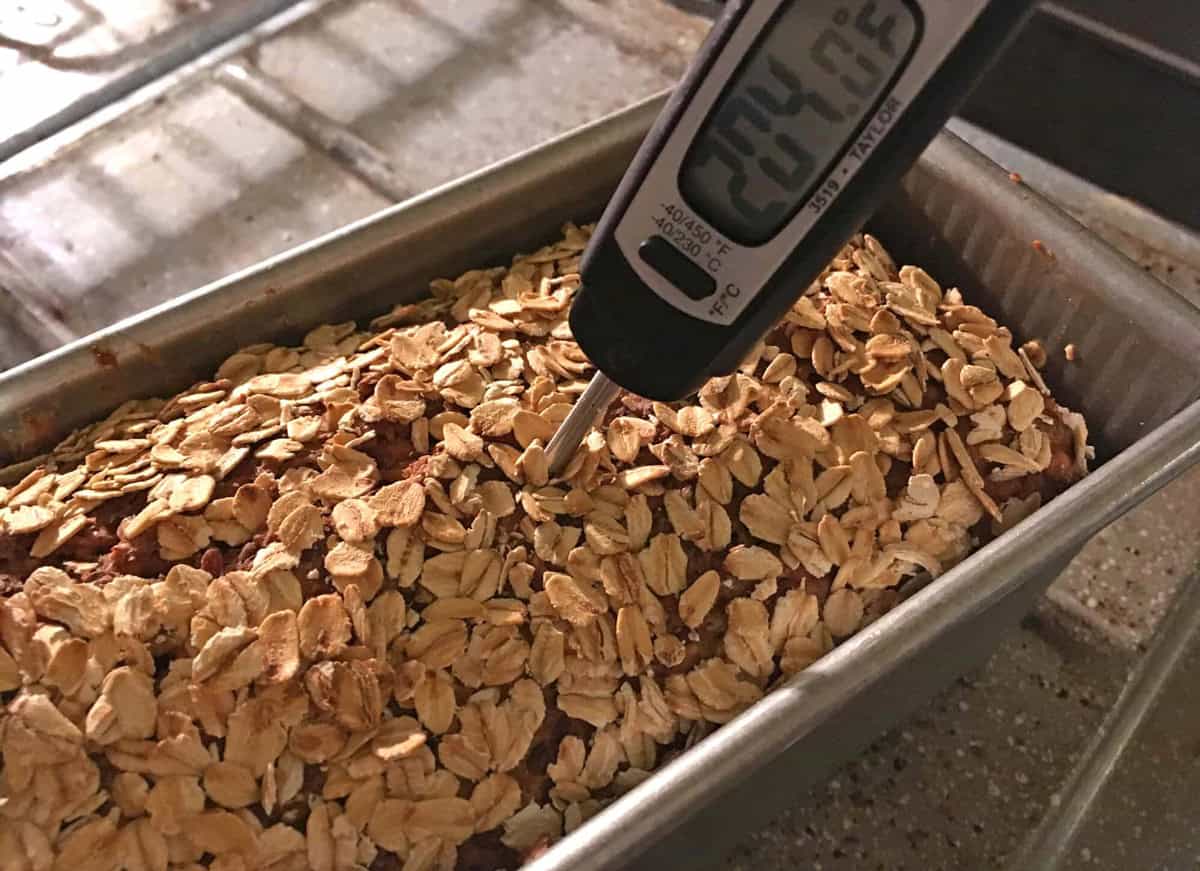
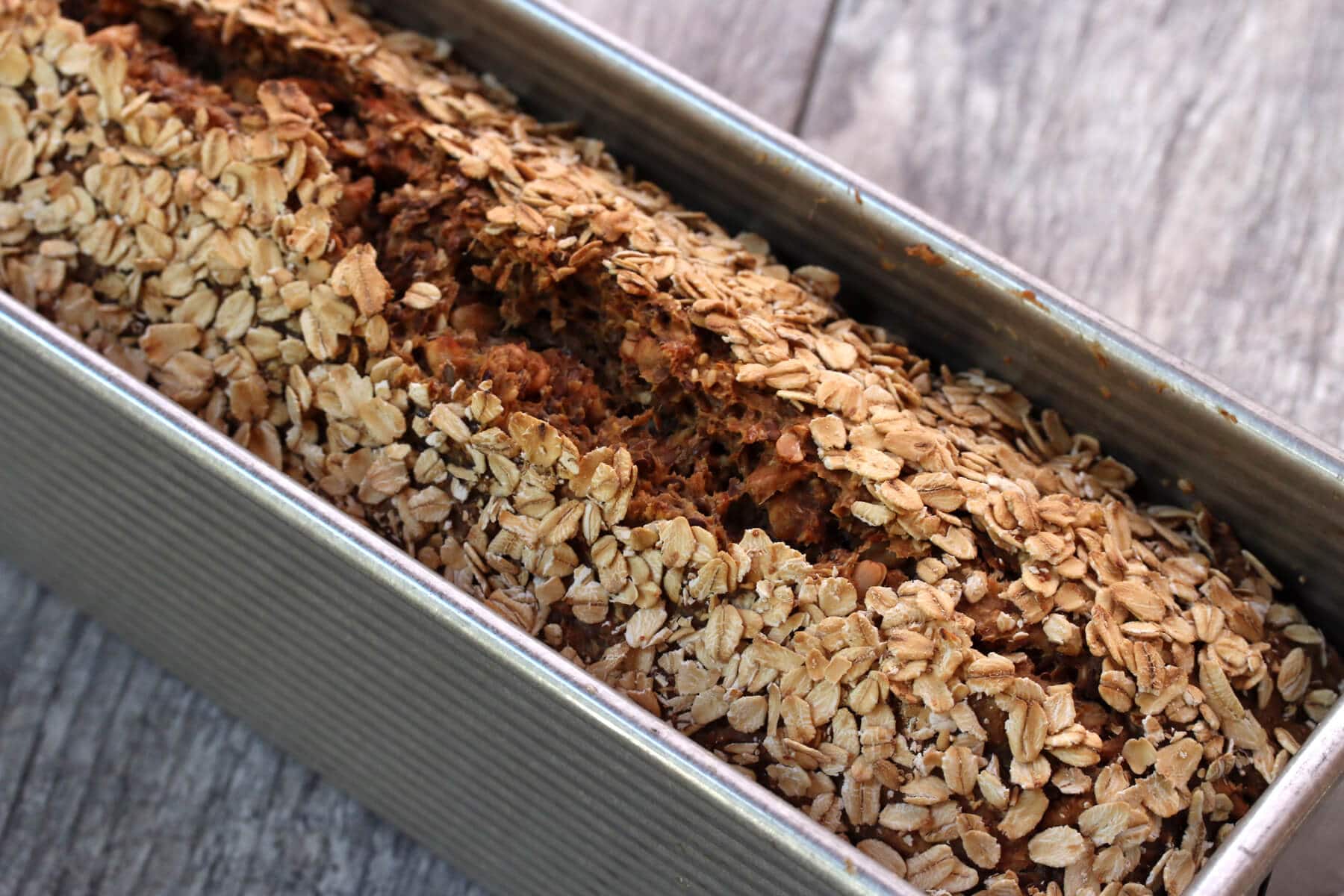
Let is sit in the pan for 5 minutes before removing it, then let it cool completely on a wire rack.
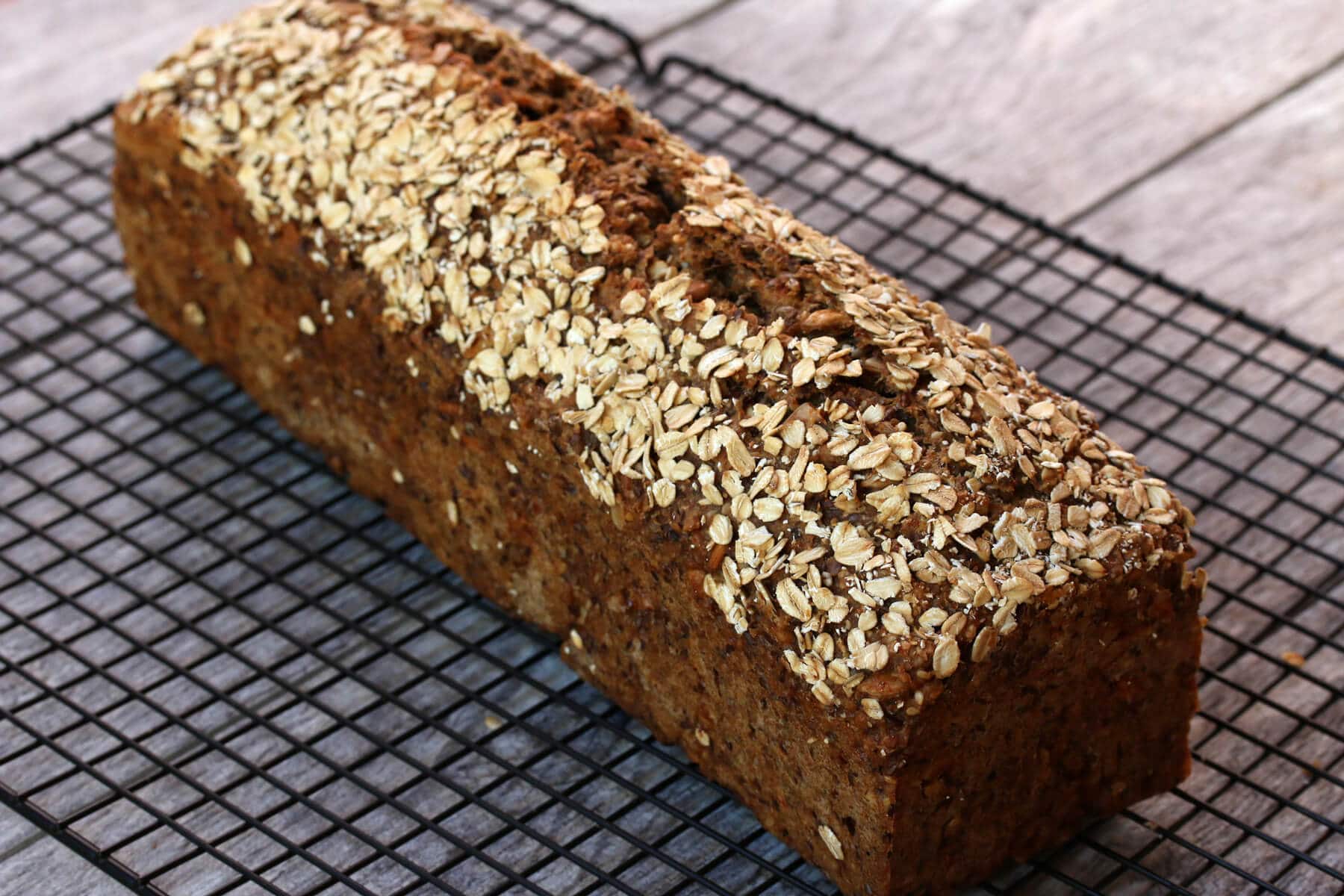
Once cooled you can slice the entire loaf in advance or slice as needed.
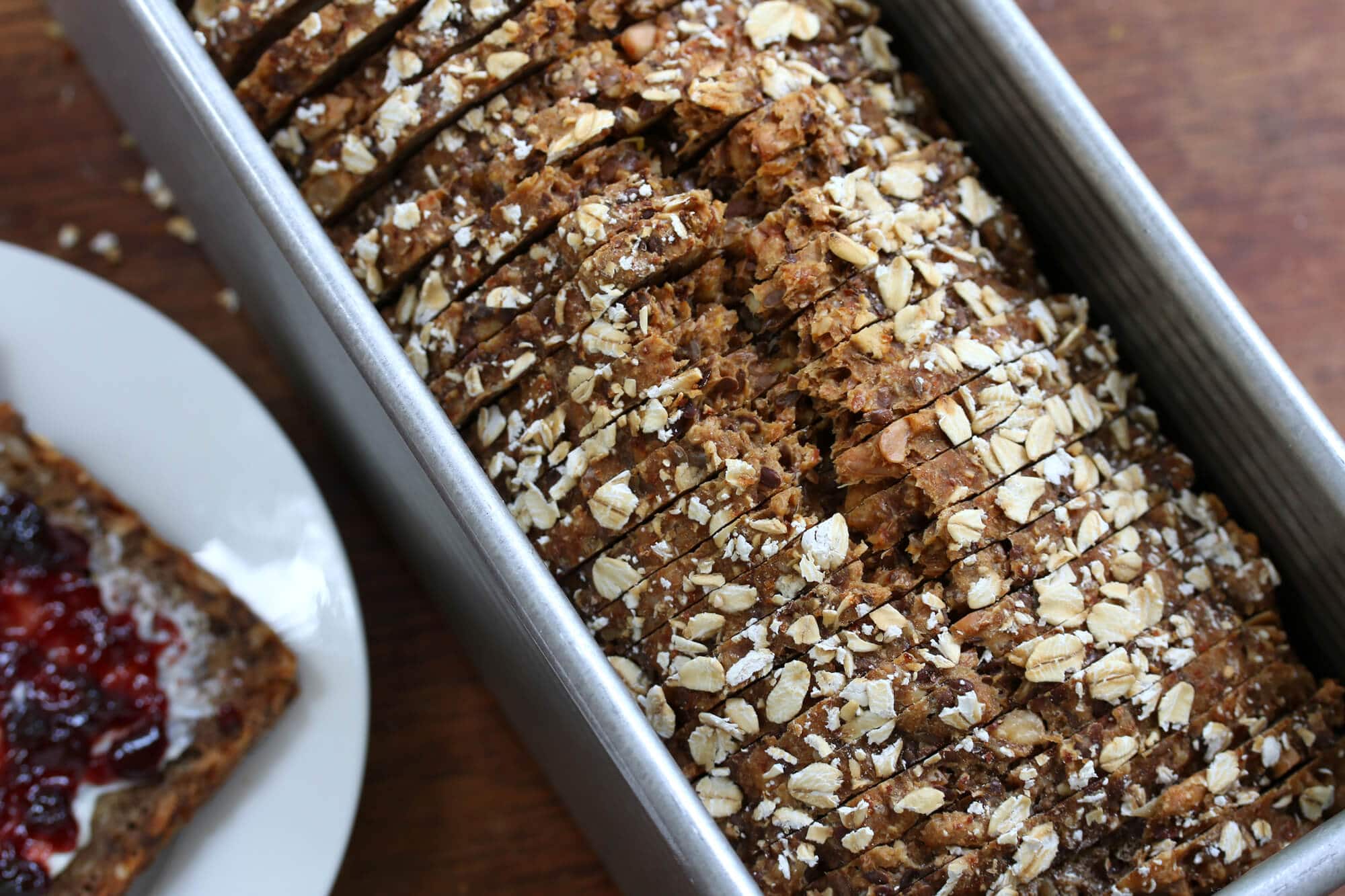
We have a decades-old Hobart commercial slicer that we picked up on Craigslist years ago. I used to be the manager of a delicatessen in England and Hobart is the gold standard in food slicers. In fact, the very same model that we have is on display at the Smithsonian!
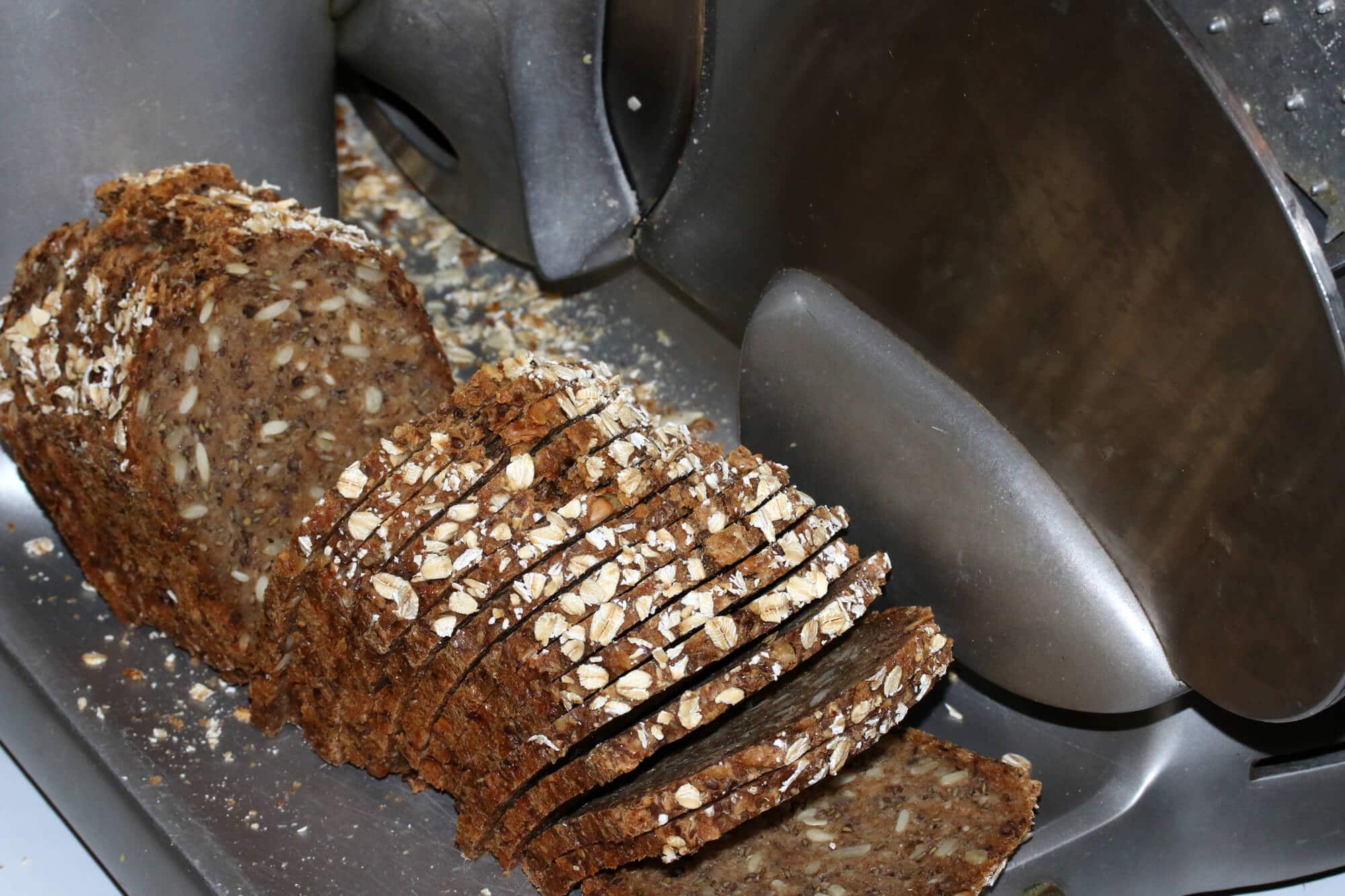
I realize we got lucky and most of you aren’t going to find a good-priced Hobart on Craigslist, but there are other good slicers on the market that are vastly cheaper and do the job. Chef’s Choice Slicers are consistently ranked at the top. I haven’t personally tried one, but they get excellent reviews. Having a good slicer to get clean, thin slices of bread that look like something you bought at a professional bakery is really nice. Plus, whenever I find chunks of cooked ham, turkey or cheese on sale I get those and slice them myself – it’s much cheaper than buying them at the deli.
At the very least you’ll need an excellent bread knife and for that my favorite knife, hands down, is the Cutco 9 3/4″ Slicer. It glides smoothly through bread and meat like no other.
Enjoy!
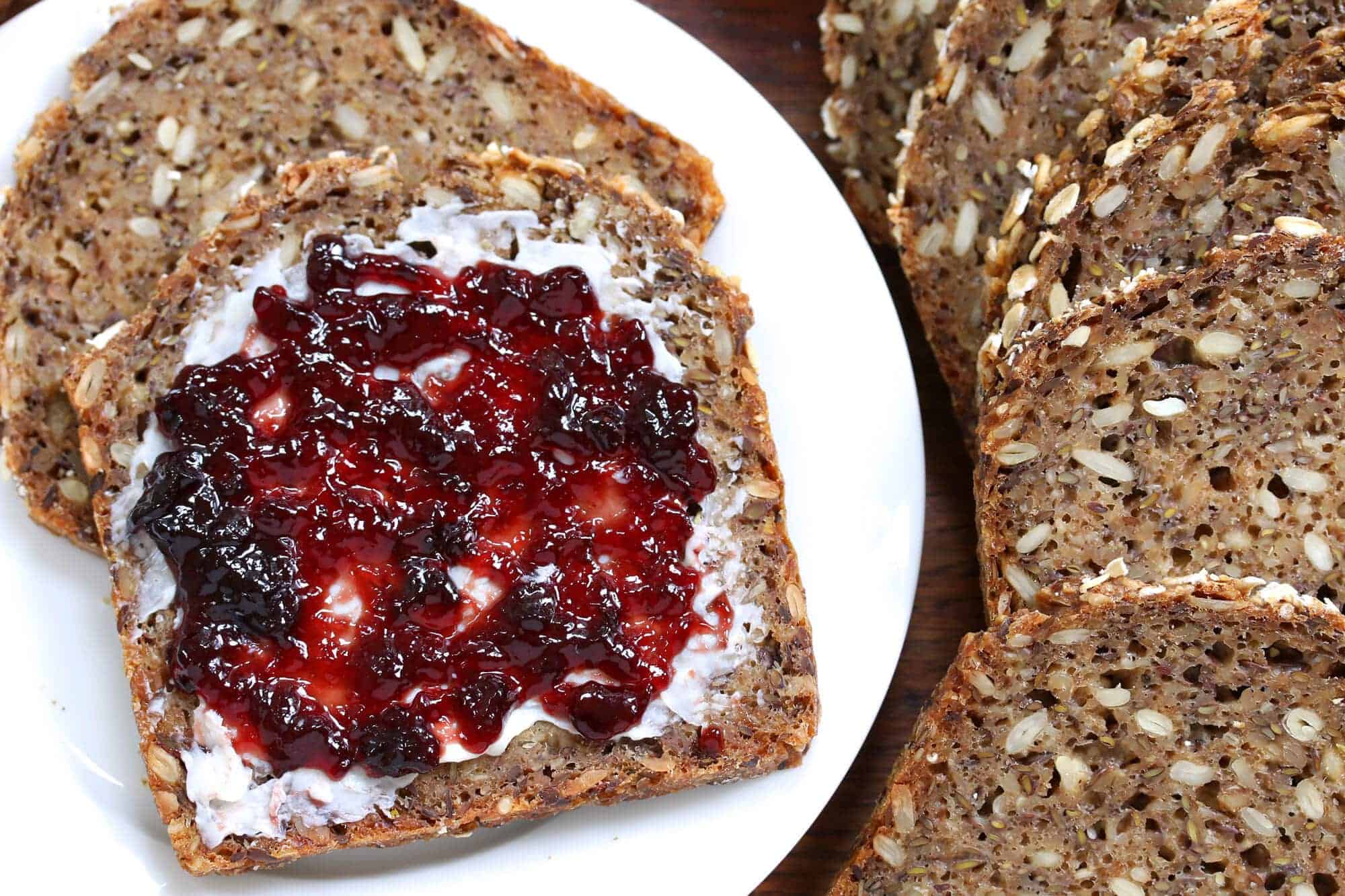
For more delicious bread from around the world be sure to try my:
- Lavash
- Injera
- Dosa
- Sourdough Naan
- Danish Rye Bread
- Crumpets
- Olive Rosemary Focaccia
- Skillet Cornbread
Save This Recipe
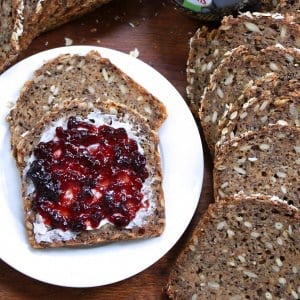
German Bread (Authentic Vollkornbrot)
Ingredients
- 4 1/2 cups einkorn flour (you can also use whole wheat, spelt, rye or combination)
- 1/2 cup whole einkorn berries , or wheat, spelt or rye berries (***See NOTE about soaking)
- 1 3/4 cups cracked einkorn berries , or wheat, spelt, rye (**See NOTE about cracking the grains **See NOTE about soaking)
- 1 cup whole flax seeds
- 1 1/2 cups sunflower seeds
- 1/4 cup sesame seeds
- 3 teaspoons salt
- 2 teaspoons dry active yeast ** see Note for sourdough substitution
- 2 tablespoons sugar , optional but recommended
- 2 cups lukewarm water
- 2 cups buttermilk , at room temperature
- 1 cup mild beer (optional, for a maltier flavor) , at room temperature (can substitute water or buttermilk instead)
- Rolled oats for sprinkling
Instructions
- Dissolve the yeast and sugar in the lukewarm water and let it sit for 5-10 minutes until frothy.
- Combine all of the dry ingredients in the bowl of a stand mixer. (You can do this by hand if you prefer.) Then add the yeast mixture along with the buttermilk and beer. Attach the dough hook and knead on the bread setting (#2) for 10 minutes. Scoop the batter into a large non-reactive bowl, cover loosely with plastic wrap, and let it sit at room temperature for at least 8 hours, preferably longer, up to 24 hours (the longer the better for the whole grain berries to soften and for heightened sourdough properties. Also the longer it ferments the more liquid will be absorbed so less chances of a moist center after baking.)
- Preheat the oven to 350 degrees F.
- Scoop the batter (it will be thick and gooey but not like regular bread dough) into a generously buttered 13x4x4 Pullman loaf pan and smooth the top to even it out. Sprinkle with oats. (Note: Baking this bread in a Pullman loaf pan yields those nice small, square slices of bread. But it also helps ensure that the center of the bread is fully cooked.) I always bake this without the lid on.
- Bake on the middle rack for 100-120 minutes or until the center is done. For best and most accurate results use an instant read thermometer and aim for 210 degrees F. Let the bread sit in the pan for 5 minutes before removing it, then let it cool completely on a wire rack before slicing it. To get clean, professional slices I highly recommend using a bread slicer.
Notes
- How to “crack” the whole berries: I use my grain mill to crack them by putting it on the coarsest setting. Another option is if you have a Vitamix and use the dry container – pulse the whole berries a few times until you get coarse pieces of einkorn. A powerful food processor will likewise do the job. Alternatively you can also place the whole berries in a ziplock bag and use a heavy object to pound them to break them up.
- Soaking the Grains: I personally don’t pre-soak the whole or cracked grain berries and just let my batter ferment for a full 24 hours which softens the berries, and I’ve always had great results. However, depending on the age of the grains you’re using (even if you just bought them they may have sat in the store or warehouse for a long time) they may require a pre-soaking in order to be adequately soft. If you wish you can pre-soak the grains overnight (pour hot water over them and let them sit) and then thoroughly draining.
- **Sourdough Substitution: To make this a sourdough Vollkornbrot omit the yeast, add 200 grams of active sourdough starter, and reduce the flour by 100 grams and the water by 100 grams. Give the batter a full 24 hour ferment.
Nutrition
Originally published on The Daring Gourmet December 11, 2019



















I have sent a separate email regarding the issue with the Pain de Mie Pan.
The Vollkornbrot is absolutely delicious!!! I just came back from Germany and had bread like this almost daily. My determination to make Vollkornbrot led me to your site and it is a WINNER! I notice you say the Pullman pan is the perfect vehicle for this bread but this recipe makes a lot of bread – too much for one person. Is it possible to halve the recipe and bake it in a regular 9×5 loaf pan?What is the best way to store the bread?
Again, thanks for a wonderful recipe!!!
Hi A., I got your email, thanks so much for that update. Hopefully you’ll never encounter a problem like that again with your new pan.
To answer your question: Yes, this does make a very large loaf for one person. It can be frozen (I recommend freezing it in slices and separate those slices between plastic wrap), but I fully understand wanting to make a smaller loaf. YES, you can absolutely half the recipe and bake it in a smaller pan. Not having tried it I’m not positive about the size, but my instinct says 9×5 may be a bit big and may result in a significantly flatter loaf. You might want to try something smaller like a 7.75×3.75 loaf pan. That’s the pan I use for a lot of small loaves. Baking time will be different so keep an eye on it. I always recommend using an instant read thermometer, it just makes bread-baking a lot easier and more accurate.
Lastly, I’m absolutely thrilled that you enjoyed this bread, thank you! Kind regards, Kimberly
Thank you for your prompt response and suggestion. I already wrote to King Arthur Flour about the pan leaking the butter. I have not heard from them but will take your advice.
The bread looks good – haven’t tasted it yet.
Well if it was King Arthur then it wasn’t a knockoff. But they have some explaining to do and I’ll be very curious what they say – let us know!
Dear Daring Gourmet,
I would like to know if you actually used a “generously buttered Pullman Loaf Pan” because I did and I have a holy mess!! I am livid!!! Within minutes of putting my generously buttered Pullman Loaf Pan (purchased via your link) into the oven, I smelled something burning. I opened the oven door to a putrid smoke – namely the butter from the generously buttered Pullman Loaf Pan was leaking and dripping out of the pan corners onto the hot oven element! I have no idea how this will affect the taste of the bread nor do I have an idea on how difficult it will be to clean the baked on butter.
Thus far my experience has been dismal – to say the least!!!!
Yes, I follow the procedure of generously buttering my Pullman loaf pan every time, that’s just standard baking procedure. You can see my step-by-step pictures in the blog post where I put the batter into my buttered Pullman. I’ve never had a problem and have never heard of that problem. The corners of my Pullman don’t have any gaps or cracks so it wouldn’t even be capable of leaking. It makes me question your Pullman pan and whether you got stuck with an inferior knock-off. If it was a recent purchase I would return it pronto.
How does baking time differ if I use a couple 8×4 bread pans? Do you know?
Made this! We let it sit for the full 24 hours. It was still bubbling with activity before we put it in the pan. So sour and good!!
One question – if we let it sit for less time, would the flavor be milder, less sour?
My husband is eating vollkronbrot and liverwurst sandwiches while I’m out of town, bless his heart.
Fantastic, Alison, I’m so glad you both enjoyed it, thank you! Yes, how long it ferments is what determines how sour vs. mild it will be, so if you let it ferment less it will be milder.
Hi,
I made a bread based on your instructions.The crust is too hard, and the whole berries never softened. I am disappointed with the results.
We tried making this last night and today and are very disappointed with the results. What we have is a brick full of very expensive ingredients. The whole einkorn berries are like eating uncooked rice. We followed the given directions,letting it set 17 hours, but did not receive anything resembling an edible bread. My suggestion is to try pre-soaking the whole and cracked berries and draining before adding them to the mix.
what size is the pullman pan for this recipe? i see several sizes listed for sale. thanks!
Hi Anya, I use the 13x4x4. Happy baking!
Hi, I just tried this for the first time and it’s in the oven as I type and I have a question: the baked loaf you have pictured here looks exactly the way the Vollkornbrot I enjoy on my frequent trips to Germany…but both the raw dough, and the finished loaf, look a little more pale than yours. However, i’m pretty sure I used the correct flour, even though I think the packaging is slightly different (the part that says “all purpose flour” is highlighted in blue)…but other than that I can’t identify where I have gone wrong…any thoughts?
Hi Cat, I’m a little confused – there is no all-purpose flour in this bread. It’s 100% whole grain. If you used all-purpose flour then that explains why your bread is lighter in color.
Hi Cat,
I have the same problem. I think Amazon is sending the wrong flour. I ordered the one mentioned in the recipe and received an Einkorn all purpose flour.
Hi Cat and Heidi, okay that makes sense, I didn’t realize you had used that specific flour. The difference in color: I grind my own flour from whole einkorn berries and I don’t sift the flour so all the bran (extra fiber) is still in my flour – that’s what makes it darker. The pre-ground flour you buy is sifted giving the loaf a lighter color. It still has all the nutrition from the germ but has that bulky bran sifted out of it.
Kimberly, the flour you posted / linked to is actually listed on Amazon as “all purpose” which sounded wrong to me in theory, but in practice is precisely what you said to buy – so, since your bread looked spot on, I didn’t balk. However, you might want to update that link. I have a new batch that is looking just fine so far, which I made with a whole wheat rye flour. Should do the trick.
Hi Cat, yes, rye will result in a darker colored loaf. I linked to that einkorn flour when I published this post because it was the only einkorn flour available at the time (it’s still a relatively “new” flour here in the U.S.). That’s also why I mention grinding my own einkorn flour from whole einkorn berries in the post. I just checked and am glad to see that they finally have the whole grain version available so I’ve updated that link. Thanks for bringing this to my attention.
Oh thank god it’s not just me!